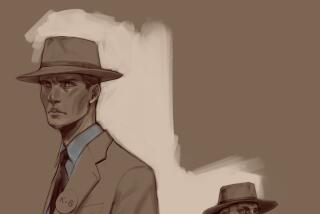A Pressing Assignment : Pasadena Art Center Students Attempt to Build a Better Iron
- Share via
In 1949, the author of “Mary Proctor’s Ironing Book, 1,016 Ways to Make Washing and Ironing Easier” took on a heavy burden: “My job,” she told her readers, “is finding out how washing and ironing can be done so that it leaves a woman unexhausted--and proud of her work.”
More than four decades later, with a little less focus on housewifery but just as much enthusiasm, a product design class of 24 men and one woman from Pasadena’s Art Center College of Design has set out to solve the very same problem.
The students have done their best to invent a better version of the iron, which historians say has been in use since long before the time of Cleopatra (who, by the way, wore pleated skirts).
That one of civilization’s earliest forms of drudgery is still haunting humankind hadn’t concerned Art Center Professor C. Martin Smith until he spent a semester teaching at the school’s European branch.
“I was horrified to find out that it cost $6 apiece to have shirts done in Switzerland,” said Smith, the college’s associate chairman of product design.
Never having ironed before, Smith became curious.
“It’s not that the iron functioned poorly,” he said. “I just wondered if it could be done better. I was curious about what could be the next level of technology for such a humdrum household object.”
Smith’s students were not initially as hot for the idea as was their professor, but they eventually came around. Their creations are on display through April at the college’s student gallery.
“At first I thought it was going to be boring,” said Richard Grazzi, 24, who was initially hoping the class would design something more exciting, such as a mass-transit system. “But it turned out to be more challenging than I expected.”
Grazzi was one of the few students who did not use the traditional triangular metal plate; he made a travel iron to be used while the garment is still on its hanger. The small, one-piece, block-like iron has a suction device that draws in the hanging garment.
“When people travel, they don’t bring an ironing board with them,” Grazzi reasoned. “So I tried to make something really simple.”
Another student, 22-year-old Aleks Tatic, said he knew so little about ironing that he decided to poll his neighbors. Using a foam-rubber model of his design, Tatic went door-to-door asking Pasadena homemakers for their opinions.
“I’m not an expert, so I wanted to get some ideas from people who iron,” Tatic said.
He found that most people actually own several irons. “One iron would give more heat, so it was good for linens,” he said. “Another was better for delicate items. It made me want to design an iron that could solve everyone’s problems.”
Tatic’s solution: Put all the controls near the thumb so the ironer can, with just a touch, increase or decrease heat or add steam.
Appearance rather than function provided the inspiration for Norm Ryang, 23. He said he tried to make an iron that would seem “hip” to his peers.
“The market I’m shooting for is the young bachelor and bachelorette,” said Ryang, who painted his aerodynamic iron heather gray with red graphics. “I tried to make it aesthetically pleasing. But you can’t get away from the fact that no one really likes to iron.”
The ironer’s lament is nothing new to art, of course. In about 1884, artist Edgar Degas apparently thought the only way to make ironing less grueling was to imbibe while completing the chore.
His painting, “Women Ironing,” shows one woman pushing down with all her might on an iron while her friend grips the neck of a wine bottle and rubs her own neck in torment.
Irons may slide more smoothly today, but technology has done little to make ironing itself more tolerable.
In 1944, Eleanor Ahern’s “The New Washday” asserted: “Washing isn’t difficult. It is the ironing that is tiresome, as any experienced laundress will tell you. The difference in these two tasks is so great that if the time comes when you have to choose between a wash woman and an ironing woman, I suggest you engage the latter and do the washing yourself.”
So with that in mind, two of Smith’s students thought of putting the ironer in a more whimsical setting.
Asko Lax and Bobby Chang made an ironing board that is meant to conjure up the image of Dumbo the elephant. Two flaps, representing Dumbo’s ears, unfold to make the board. The cord of the iron becomes his tail.
Most of the students, though, tried to solve particular problems associated with ironing.
One student designed an iron with a removable container: The entire apparatus doesn’t have to be hauled to the sink for a fill-up. Another gave his iron a rechargeable battery: Tripping or fumbling over the cord is not a problem.
Yet another created a device that automatically lifts the iron when the user releases the handle, thus preventing clothes from burning.
Ginger Lin, the only woman in the class, designed an iron that is shaped like the bottom of a rocking chair. It is meant to be easier to move back and forth. “I wanted to break away from the traditional shape,” said Lin, 25.
“Most of the guys are focusing on function, but I wanted to go beyond that--to make it more attractive to women who have to iron.”
More to Read
The biggest entertainment stories
Get our big stories about Hollywood, film, television, music, arts, culture and more right in your inbox as soon as they publish.
You may occasionally receive promotional content from the Los Angeles Times.










